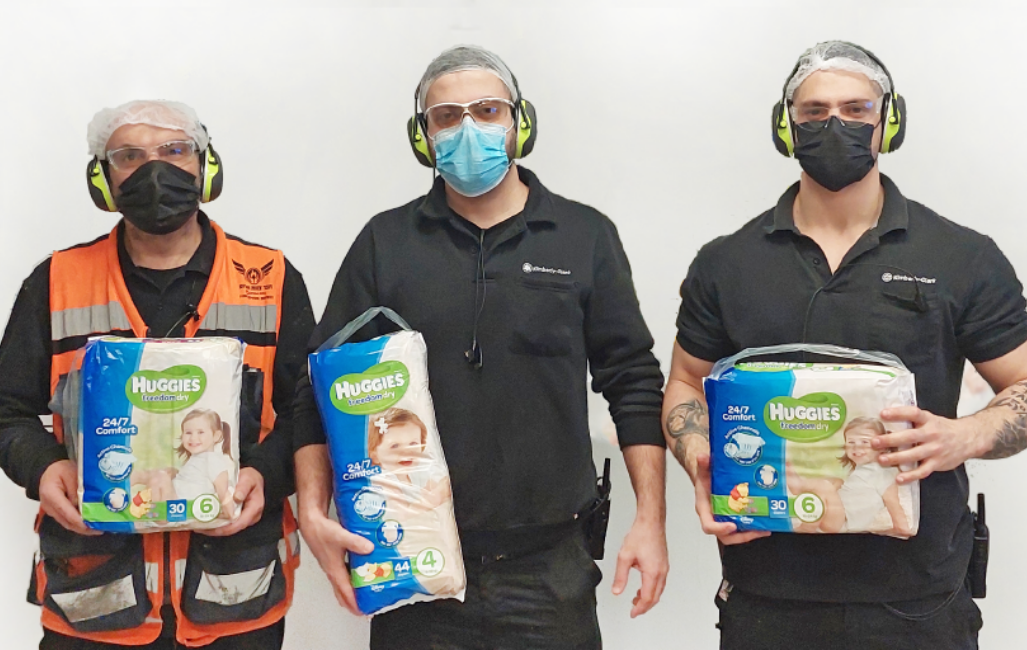As a Kimberly-Clark team member, you’re our most important asset, and that’s why safety is paramount in our manufacturing facilities and distribution centers.
Any injury – no matter how minor – is one too many.
With this in mind, we launched the Environmental and Safety Transformation Initiative in early 2020, a program to raise all facilities to an even higher standard of safety criteria by 2022.
Called Level 3, it means that everyone holds themselves and each other accountable to Kimberly-Clark’s six leadership safety imperatives – even if it means shutting down the production line.
It’s a mindset, responsibility, and way of life to ensure that all team members are safe each and every day, embodying Kimberly-Clark’s values of caring, owning, and acting.
Kimberly-Clark’s manufacturing facility in Afula, Israel, exemplifies this strategy.
Over the past two years, the Afula team has seen its safety performance rise and its incident rate drop – a reflection of the ownership each team member takes in protecting themselves and their colleagues from harm.
A Roadmap to Safety
In early 2020, the Afula team, along with all other Kimberly-Clark manufacturing and distribution sites, embarked on a safety maturity journey with three goals: improving leader and employee mindsets, behaviors, and capabilities; reducing risk and risk tolerance; and facilitating continuous improvement through systems and employee engagement.
In less than two years, the manufacturing facility has already surpassed the Level 3 rating.
It wasn’t an easy start. “The facility had undergone several changes leading up to this point, including a reduction in workforce and installation of new production capabilities,” said Afula plant manager Amir Berman. “And while safety is a 24/7 necessity, it wasn’t always the main focus for the team.”
Changing Hearts and Minds
Helping a team of 140 employees change their mindsets and behaviors and improve their capabilities is a challenging task, and Amir knew he had to set the tone.
“As a leader, it’s easy to get distracted because you’re often so focused on results,” Amir said. “I knew the change had to start with me. I needed to own safety.”
That began by implementing what’s known as Leader Standard Work (LSW), a set of checkpoints to ensure that things are running safely and to standard. LSW also includes identifying opportunities to engage with employees, leading by example, and demonstrating daily decisions to put safety first.
“The only way to do this was to build trust and ensure that every manager took ownership of the maturity journey so that they were committed to success,” said Meir Pinto, the site’s environmental health and safety leader.
This was easier said than done, especially in early 2020, when the world was reckoning with a social justice movement and an unprecedented global pandemic. Building trust had to start by walking the talk.
“Role modeling is key,” Amir said. “I can’t ask my team to follow rules if I’m not following them myself. They needed to see that safety is always top of mind, and it needs to be consistent.”
Amir and Meir both engaged in daily LSW, which involved observing the team at work, talking to them about Kimberly-Clark’s three safety obligations – to see, own, and solve safety, and asking them to identify risks at their workstations. The pinnacle was addressing their concerns with action.
“We needed to demonstrate care and act quickly to eliminate safety hazards and gaps so the team could see leaders immediately addressing issues that arise,” Amir said. “It showed them that we mean what we say.”
Awareness Leads to Action
The facility leaders implemented a three-layer process to maximize safety ownership.
The first layer was capacity building, in which employees became more familiar with the safety requirements and expectations associated with local regulatory requirements and Kimberly-Clark’s internal standards.
The second was gap mapping, where the team evaluated which requirements they consistently met and which areas needed improvement. This part is the “great advantage” of the maturity model methodology, Meir said.
“The very execution of self-evaluation and the gap-mapping process caused us to be more focused and build an improvement plan based on the findings we discovered,” he said. “We were able to create a plan to close the risk gaps and a process to keep them closed.”
The third layer was engaging employees to identify safety solutions and ways of working. This meant involving and connecting them to proactive safety activities such as daily floor conversations, four-step problem solving, participating in safety committees, and sharing observations and concerns. They also delegated decision making so employees could learn from and proactively take responsibility for each other and the process.
In the end, Afula’s success was built on trust and ownership.
“Safety must come first, so if we need to stop the line, we do it. We don’t cut corners,” said Amir. “This mindset drives greater awareness and efficiency, and ultimately better results. We take care of our most important asset – our employees.”




